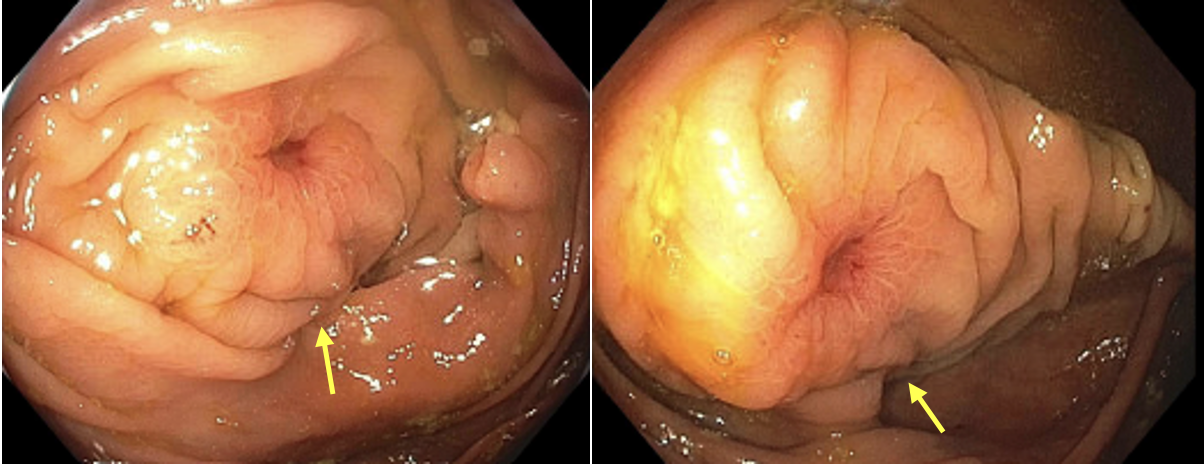Monday Poster Session
Category: General Endoscopy
P3017 - Goblet Cell Adenocarcinoma With Signet Ring Features: A Rare and Aggressive Lesion Unveiled During Routine Colonoscopy
Monday, October 27, 2025
10:30 AM - 4:00 PM PDT
Location: Exhibit Hall

Pei-Hsuan Li, DO (she/her/hers)
Oregon Health & Science University
Portland, OR
Presenting Author(s)
Pei-Hsuan Li, DO, Jennifer Rodriguez, MD, Melissa Hershman, MD, BSN
Oregon Health & Science University, Portland, OR
Introduction: Goblet cell adenocarcinoma (GCA) of the appendix is a rare but highly aggressive malignancy, accounting for approximately 15% of appendiceal neoplasms. It is often diagnosed incidentally during appendectomy and typically presents at an advanced stage. Due to its rapid progression and late presentation, GCA is associated with poor median overall survival. Among its subtypes, high grade GCA with signet ring cells is linked to worse outcomes. We present a case where subtle mucosal changes at the appendiceal orifice during routine colonoscopy led to an unexpected diagnosis of GCA, underscoring the importance of recognizing early endoscopic findings.
Case Description/
Methods: A 72-year-old male undergoing surveillance colonoscopy was found to have focal erythema and puckering at the appendiceal orifice (Figure 1). Biopsy showed poorly differentiated adenocarcinoma with signet ring cell features, with pathology confirming subtle invasive clusters within the lamina propria. Subsequent CT imaging revealed a mildly prominent appendix but no definitive mass or evidence of metastatic disease (Figure 2). He underwent laparoscopic right hemicolectomy. Surgical pathology confirmed high-grade GCA with signet ring morphology, extensive lymphovascular and perineural invasion, and a peritoneal nodule consistent with metastatic disease, despite no gross peritoneal involvement. The patient declined adjuvant chemotherapy and was monitored by oncology. He initially remained stable but later developed worsening abdominal symptoms. Repeat imaging revealed progression of peritoneal metastases, with new ascites and peritoneal thickening suggestive of mucinous carcinomatosis. He transitioned to hospice and passed away in months.
Discussion: GCA of the appendix is rare and typically lacks specific symptoms or distinct endoscopic features that would prompt targeted screening. Clinical presentation can range from asymptomatic to, most commonly, signs of acute appendicitis due to tumor-related obstruction and inflammation. Routine colonoscopy is not intended to evaluate the appendiceal orifice, yet this case highlights subtle mucosal changes in this region that should not be overlooked, as they may indicate serious pathology. Although GCA with signet ring features is known for its aggressive behavior, there is limited understanding of its course when identified at an early stage. Increased endoscopic vigilance and further research are needed to determine whether earlier diagnosis meaningfully improves outcomes.

Figure: Figure 1: Subtle erythema and puckering at the appendiceal orifice

Figure: Figure 2: CT abdomen/pelvis demonstrating mildly prominent appendix
Disclosures:
Pei-Hsuan Li indicated no relevant financial relationships.
Jennifer Rodriguez indicated no relevant financial relationships.
Melissa Hershman indicated no relevant financial relationships.
Pei-Hsuan Li, DO, Jennifer Rodriguez, MD, Melissa Hershman, MD, BSN. P3017 - Goblet Cell Adenocarcinoma With Signet Ring Features: A Rare and Aggressive Lesion Unveiled During Routine Colonoscopy, ACG 2025 Annual Scientific Meeting Abstracts. Phoenix, AZ: American College of Gastroenterology.
Oregon Health & Science University, Portland, OR
Introduction: Goblet cell adenocarcinoma (GCA) of the appendix is a rare but highly aggressive malignancy, accounting for approximately 15% of appendiceal neoplasms. It is often diagnosed incidentally during appendectomy and typically presents at an advanced stage. Due to its rapid progression and late presentation, GCA is associated with poor median overall survival. Among its subtypes, high grade GCA with signet ring cells is linked to worse outcomes. We present a case where subtle mucosal changes at the appendiceal orifice during routine colonoscopy led to an unexpected diagnosis of GCA, underscoring the importance of recognizing early endoscopic findings.
Case Description/
Methods: A 72-year-old male undergoing surveillance colonoscopy was found to have focal erythema and puckering at the appendiceal orifice (Figure 1). Biopsy showed poorly differentiated adenocarcinoma with signet ring cell features, with pathology confirming subtle invasive clusters within the lamina propria. Subsequent CT imaging revealed a mildly prominent appendix but no definitive mass or evidence of metastatic disease (Figure 2). He underwent laparoscopic right hemicolectomy. Surgical pathology confirmed high-grade GCA with signet ring morphology, extensive lymphovascular and perineural invasion, and a peritoneal nodule consistent with metastatic disease, despite no gross peritoneal involvement. The patient declined adjuvant chemotherapy and was monitored by oncology. He initially remained stable but later developed worsening abdominal symptoms. Repeat imaging revealed progression of peritoneal metastases, with new ascites and peritoneal thickening suggestive of mucinous carcinomatosis. He transitioned to hospice and passed away in months.
Discussion: GCA of the appendix is rare and typically lacks specific symptoms or distinct endoscopic features that would prompt targeted screening. Clinical presentation can range from asymptomatic to, most commonly, signs of acute appendicitis due to tumor-related obstruction and inflammation. Routine colonoscopy is not intended to evaluate the appendiceal orifice, yet this case highlights subtle mucosal changes in this region that should not be overlooked, as they may indicate serious pathology. Although GCA with signet ring features is known for its aggressive behavior, there is limited understanding of its course when identified at an early stage. Increased endoscopic vigilance and further research are needed to determine whether earlier diagnosis meaningfully improves outcomes.

Figure: Figure 1: Subtle erythema and puckering at the appendiceal orifice

Figure: Figure 2: CT abdomen/pelvis demonstrating mildly prominent appendix
Disclosures:
Pei-Hsuan Li indicated no relevant financial relationships.
Jennifer Rodriguez indicated no relevant financial relationships.
Melissa Hershman indicated no relevant financial relationships.
Pei-Hsuan Li, DO, Jennifer Rodriguez, MD, Melissa Hershman, MD, BSN. P3017 - Goblet Cell Adenocarcinoma With Signet Ring Features: A Rare and Aggressive Lesion Unveiled During Routine Colonoscopy, ACG 2025 Annual Scientific Meeting Abstracts. Phoenix, AZ: American College of Gastroenterology.
